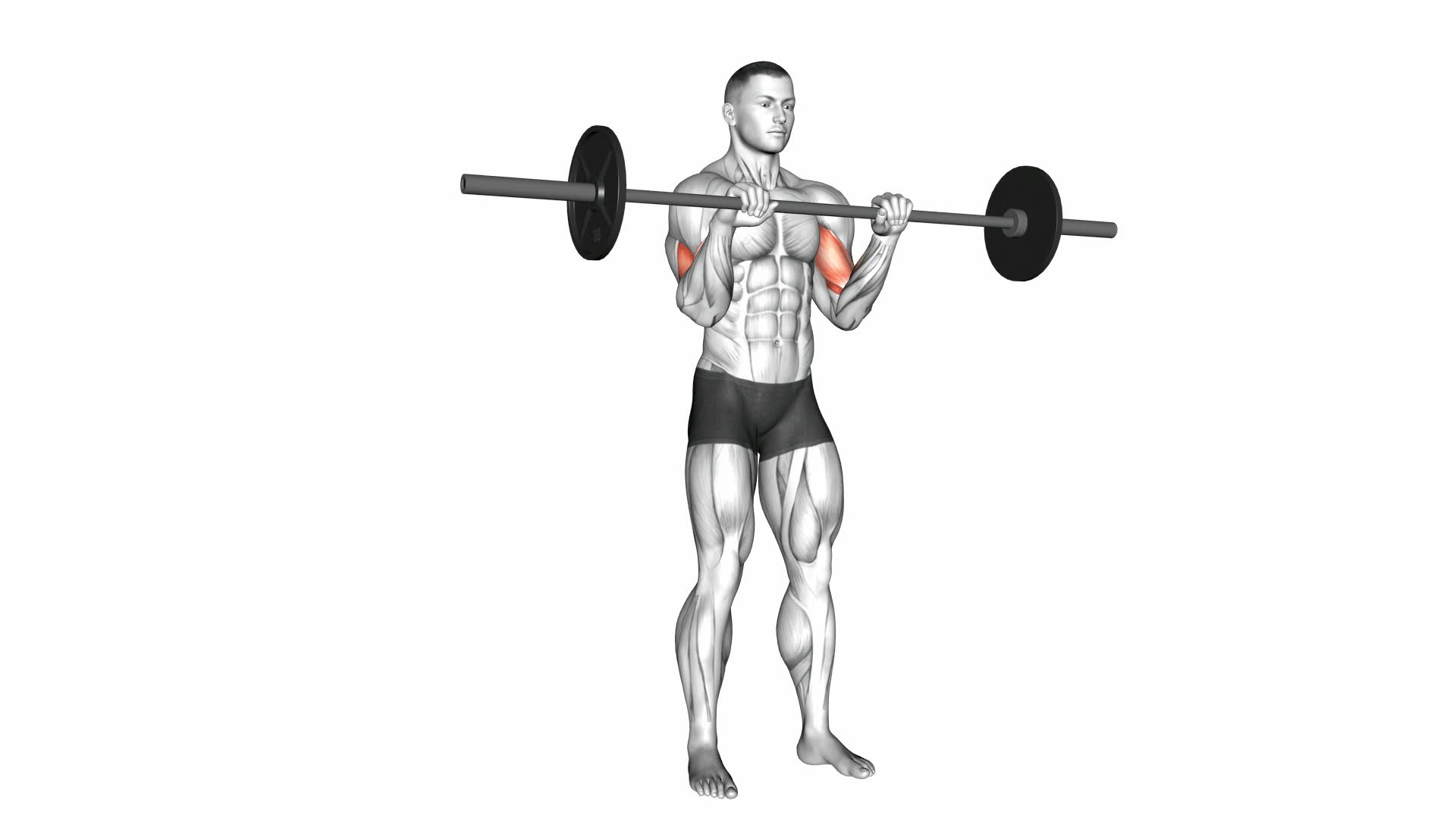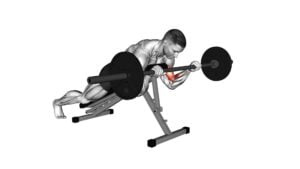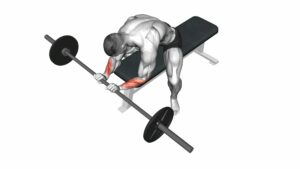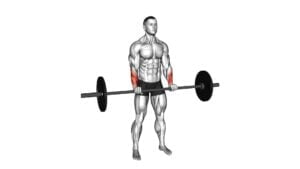Barbell Reverse Curl – Video Exercise Guide & Tips

Looking to build stronger biceps? The Barbell Reverse Curl is the exercise for you.
Watch This Exercise Video
In this video exercise guide, we'll show you the proper form and technique, as well as variations and progressions to challenge yourself.
Avoid common mistakes and get the maximum results with our helpful tips.
Get ready to flex those guns and take your arm strength to the next level with the Barbell Reverse Curl.
Let's get started!
Key Takeaways
- Barbell reverse curl targets muscles in the forearms and biceps, specifically the brachialis, brachioradialis, and biceps brachii.
- This exercise allows for balanced development of arm muscles and can increase strength and muscle growth.
- Proper form and technique are essential, including maintaining an overhand grip on the barbell, a shoulder-width stance, and curling the barbell towards the shoulders while keeping the elbows stationary and wrists straight.
- Variations and progressions of the exercise, such as using incline or different equipment, can target the muscles differently and increase the challenge.
Benefits of Barbell Reverse Curl
To maximize your gains, focus on the benefits of the barbell reverse curl. This exercise specifically targets the muscles in your forearms and biceps. By gripping the barbell with an overhand grip and curling it towards your shoulders, you engage the brachialis, brachioradialis, and the biceps brachii muscles. Unlike traditional bicep curls, the barbell reverse curl places more emphasis on the brachialis and brachioradialis, which are often neglected in regular bicep exercises. This variation allows for a more balanced development of the muscles in your arms.
In addition to targeting specific muscles, the barbell reverse curl also offers other benefits. By using a barbell, you can lift heavier weights compared to using dumbbells, which can lead to increased strength and muscle growth. The reverse grip also helps to improve grip strength, which can be beneficial for other exercises such as deadlifts and pull-ups.
To perform the barbell reverse curl, start with a shoulder-width grip on the barbell, keeping your arms fully extended. Curl the barbell towards your shoulders, making sure to keep your elbows stationary and your wrists straight. Slowly lower the barbell back to the starting position and repeat for the desired number of repetitions.
Incorporating the barbell reverse curl into your arm workouts can help you achieve stronger, more defined arms.
Proper Form and Technique
To perform the barbell reverse curl with proper form and technique, grip the barbell with an overhand grip and maintain a shoulder-width stance. Here are some key points to keep in mind:
- Muscles targeted during barbell reverse curl:
- Brachioradialis: This muscle is located in the forearm and is primarily responsible for flexing the elbow.
- Biceps brachii: The biceps are located in the upper arm and play a role in both elbow flexion and forearm supination.
- Brachialis: Situated underneath the biceps, the brachialis assists in elbow flexion.
Recommended sets and reps for barbell reverse curl:
- Beginners: Start with 2-3 sets of 8-12 repetitions. Focus on maintaining proper form and gradually increase the weight as you become more comfortable.
- Intermediate: Aim for 3-4 sets of 8-10 repetitions. Use a challenging weight that allows you to complete the desired number of reps with good form.
- Advanced: Perform 4-5 sets of 6-8 repetitions. Increase the weight to a level where the last few reps of each set are challenging but still manageable.
Variations and Progressions
Now let's explore different variations and progressions of the barbell reverse curl to further challenge your muscles and continue your strength training journey.
As you become more experienced with the exercise, you can incorporate advanced techniques to target specific muscle groups and increase the intensity of your workout.
One advanced technique you can try is the incline barbell reverse curl. This variation involves performing the exercise on an inclined bench, which places more emphasis on the brachialis and brachioradialis muscles. By changing the angle of your body, you can challenge your muscles in a different way and stimulate further growth.
Another option is to use different equipment for the reverse curl. Instead of using a barbell, you can use dumbbells or an EZ bar. This can provide a greater range of motion and allow for a more natural grip, which can help prevent wrist discomfort.
To further progress in your training, you can also increase the weight or the number of repetitions you perform. Gradually adding more resistance or volume will help you continue to challenge your muscles and promote strength gains.
Remember to always use proper form and technique when performing any variation or progression of the barbell reverse curl. This will ensure that you're targeting the intended muscle groups and reducing the risk of injury.
Common Mistakes to Avoid
To avoid common mistakes, make sure you maintain proper form and technique while performing the barbell reverse curl. Here are a few common mistakes to watch out for:
- Using momentum: One of the most common mistakes is using momentum to lift the barbell. This not only reduces the effectiveness of the exercise but also increases the risk of injury. Instead, focus on using your biceps to lift the weight and control the movement.
- Swinging your body: Another mistake to avoid is swinging your body during the exercise. This can happen when the weight is too heavy or when you're not engaging your core muscles properly. Keep your body stable and avoid any unnecessary movements.
- Curling your wrists: It's important to maintain a neutral wrist position throughout the exercise. Curling your wrists can put unnecessary strain on your joints and decrease the effectiveness of the exercise. Keep your wrists straight and focus on using your biceps to lift the weight.
Tips for Maximum Results
Get the most out of your barbell reverse curls with these tips for maximum results.
When it comes to training frequency, aim to perform this exercise at least twice a week with a day of rest in between sessions. This will allow your muscles to recover and grow stronger.
Additionally, consider incorporating supersets into your workout routine. Supersets involve performing two exercises back-to-back without rest. For example, you can pair barbell reverse curls with tricep dips or shoulder presses. This will help increase the intensity of your workout and stimulate more muscle fibers.
Remember to start with a weight that challenges you but still allows for proper form. Gradually increase the weight as you get stronger to continue seeing progress.
Focus on maintaining proper posture throughout the exercise, keeping your core engaged and your back straight.
Finally, don't forget to stretch and cool down after your workout to prevent muscle soreness and promote recovery.
Frequently Asked Questions
Can the Barbell Reverse Curl Help in Building Bicep Strength?
Yes, the barbell reverse curl can definitely help build bicep strength. By performing this exercise with the proper form, you can effectively target your biceps and increase their strength.
Incorporating the barbell reverse curl into your workout routine offers several benefits, such as improving overall arm strength, enhancing grip strength, and promoting better muscle balance.
Make sure to use the correct technique to maximize the effectiveness of this exercise.
Is the Barbell Reverse Curl Suitable for Beginners?
The barbell reverse curl technique can be suitable for beginners.
It's a great exercise for building bicep strength and adding definition to your arms.
By gripping the barbell with an overhand grip and curling it towards your shoulders, you target the brachialis muscle in addition to the biceps.
This exercise can help beginners develop proper form, build strength, and improve their overall upper body strength.
How Often Should I Perform the Barbell Reverse Curl Exercise?
To get the optimal benefits from the barbell reverse curl, you should perform it at least 2-3 times a week. This frequency allows for proper muscle recovery while still challenging your biceps.
By incorporating the barbell reverse curl into your routine, you'll strengthen your forearms and improve your grip strength. Plus, it's a great exercise for targeting the brachialis muscle, which can help add size and definition to your arms.
Can the Barbell Reverse Curl Help in Improving Grip Strength?
Yes, the barbell reverse curl can definitely help in improving grip strength. Grip strength training has numerous benefits, such as enhancing overall upper body strength and improving performance in various sports and activities.
In addition to the barbell reverse curl, other effective exercises for improving grip strength include deadlifts, farmer's walks, and hanging from a pull-up bar.
Incorporating these exercises into your routine can lead to significant improvements in your grip strength over time.
Are There Any Alternatives to the Barbell Reverse Curl Exercise?
Looking for alternative exercises to the barbell reverse curl?
There are several options you can try.
Dumbbell reverse curls are a great alternative that target the same muscles.
Another option is using a resistance band to perform reverse curls.
These exercises can provide similar benefits to the barbell reverse curl, such as strengthening your forearm and improving grip strength.
Conclusion
In conclusion, the barbell reverse curl is a highly effective exercise for targeting the forearm muscles. By maintaining proper form and technique, you can maximize results and avoid common mistakes.
Additionally, incorporating variations and progressions into your workout routine can help you continually challenge your muscles and see continued progress.
Remember to always listen to your body and consult with a fitness professional if you have any concerns or questions.

Author
Years ago, the spark of my life’s passion ignited in my mind the moment I stepped into the local gym for the first time. The inaugural bead of perspiration, the initial endeavor, the very first surge of endorphins, and a sense of pride that washed over me post-workout marked the beginning of my deep-seated interest in strength sports, fitness, and sports nutrition. This very curiosity blossomed rapidly into a profound fascination, propelling me to earn a Master’s degree in Physical Education from the Academy of Physical Education in Krakow, followed by a Sports Manager diploma from the Jagiellonian University. My journey of growth led me to gain more specialized qualifications, such as being a certified personal trainer with a focus on sports dietetics, a lifeguard, and an instructor for wellness and corrective gymnastics. Theoretical knowledge paired seamlessly with practical experience, reinforcing my belief that the transformation of individuals under my guidance was also a reflection of my personal growth. This belief holds true even today. Each day, I strive to push the boundaries and explore new realms. These realms gently elevate me to greater heights. The unique combination of passion for my field and the continuous quest for growth fuels my drive to break new ground.







